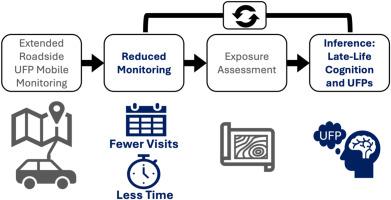超细颗粒与晚年认知功能:固定式移动监测设计对健康推断的影响
IF 7.3
2区 环境科学与生态学
Q1 ENVIRONMENTAL SCIENCES
引用次数: 0
摘要
越来越多的证据表明超细颗粒(UFP)与神经毒性有关,但人体研究仍然有限。各种移动监测方法已被用于开发空气污染暴露模型。然而,设计选择是否影响流行病学,包括UFP和认知功能,仍然不清楚。我们利用专门为流行病学设计的广泛的路边移动监测活动,评估了成人思想变化队列(N= 5283)中5年平均UFP数浓度(PNC)与晚年认知功能(认知能力筛查工具-项目反应理论[CASI-IRT])之间的调整关系。为了评估减少监测方法对这种关联的影响,我们从活动中反复取样UFP测量值,开发暴露模型,并评估关联受到影响的程度。在初步分析中,PNC每增加1,900 pt/cm3,与调整后基线CASI-IRT评分升高0.002 (95% CI: -0.016, 0.020)相关,无统计学意义。在每个站点访问次数较少(≤12次)、较少季节(1-3次)和不同站点访问频率不平衡的采样设计中,点估计是一致的。限于高峰时间的抽样设计比工作时间设计(0.006,IQR: 0.005, 0.007)更相似(中位数估计为0.002,点估计的IQR: 0.000, 0.003),但当应用时间调整时情况正好相反(高峰时间:-0.003,IQR: -0.005, -0.001;商业:0.002,IQR: 0.001, 0.004)。我们在敏感性和二次分析中观察到类似的结果。在完全调整的模型中,我们没有发现UFP和认知功能之间存在关联的证据。在这种情况下,监测设计对推断结果的影响很小,这可能是由于缺乏关联造成的。在一个可能混淆的简化模型中进行的二次分析表明,监测设计可能对其他数据集产生更大的影响。需要进一步的研究,特别是在统计上具有显著健康关联的背景下。本文章由计算机程序翻译,如有差异,请以英文原文为准。


Ultrafine particles and late-life cognitive function: Influence of stationary mobile monitoring design on health inferences
Growing evidence links ultrafine particles (UFP) to neurotoxicity, but human studies remain limited. Various mobile monitoring approaches have been used to develop air pollution exposure models. However, whether design choices impact epidemiology, including for UFP and cognitive function, remains unclear.
We evaluated the adjusted association between 5-year average UFP number concentration (PNC) and late-life cognitive function (Cognitive Abilities Screening Instrument – Item Response Theory [CASI-IRT]) in the Adult Changes in Thought cohort (N = 5283) by leveraging an extensive roadside mobile monitoring campaign specifically designed for epidemiology. To assess the impact of reduced monitoring approaches on this association, we repeatedly subsampled UFP measures from the campaign, developed exposure models, and evaluated the degree to which associations were impacted.
In the primary analysis, each 1900 pt/cm3 increment in PNC was associated with an adjusted mean baseline CASI-IRT score that was 0.002 (95 % CI: −0.016, 0.020) higher, which was not statistically significant. Point estimates were consistent across sampling designs with fewer visits per site (≤12), fewer seasons (1–3), and unbalanced visit frequency across sites. Sampling designs restricted to rush hours were more similar (median point estimate 0.002, IQR of point estimates: 0.000, 0.003) than business hour designs (0.006, IQR: 0.005, 0.007), but the opposite was true when temporal adjustments were applied (rush: −0.003, IQR: −0.005, −0.001; business: 0.002, IQR: 0.001, 0.004). We observed similar results in sensitivity and secondary analyses.
We did not find evidence of an association between UFP and cognitive function in fully adjusted models. Monitoring design had minimal impact on the inferential results in this setting, which may have been caused by the lack of association. Secondary analyses in a reduced model that is potentially confounded suggest that monitoring design might have a greater impact in other datasets. Further research is needed, particularly in contexts with robust statistically significant health associations.
求助全文
通过发布文献求助,成功后即可免费获取论文全文。
去求助
来源期刊

Environmental Pollution
环境科学-环境科学
CiteScore
16.00
自引率
6.70%
发文量
2082
审稿时长
2.9 months
期刊介绍:
Environmental Pollution is an international peer-reviewed journal that publishes high-quality research papers and review articles covering all aspects of environmental pollution and its impacts on ecosystems and human health.
Subject areas include, but are not limited to:
• Sources and occurrences of pollutants that are clearly defined and measured in environmental compartments, food and food-related items, and human bodies;
• Interlinks between contaminant exposure and biological, ecological, and human health effects, including those of climate change;
• Contaminants of emerging concerns (including but not limited to antibiotic resistant microorganisms or genes, microplastics/nanoplastics, electronic wastes, light, and noise) and/or their biological, ecological, or human health effects;
• Laboratory and field studies on the remediation/mitigation of environmental pollution via new techniques and with clear links to biological, ecological, or human health effects;
• Modeling of pollution processes, patterns, or trends that is of clear environmental and/or human health interest;
• New techniques that measure and examine environmental occurrences, transport, behavior, and effects of pollutants within the environment or the laboratory, provided that they can be clearly used to address problems within regional or global environmental compartments.
 求助内容:
求助内容: 应助结果提醒方式:
应助结果提醒方式:


